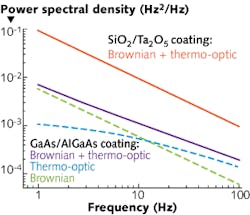Ultrasensitive interferometers and ultrastable laser sources depend on cavity mirrors that exhibit excellent optical and mechanical performance. In the past decade, the mechanical damping of high-reflectivity amorphous multilayer coatings has only improved by a factor of two. But just recently, researchers from the University of Vienna and Crystalline Mirror Solutions (both in Vienna, Austria) in collaboration with JILA, the joint institute of the University of Colorado at Boulder and the National Institute of Standards and Technology (Boulder, CO), have demonstrated direct-bonded monocrystalline multilayer coatings or “crystalline coatings” with intrinsically low mechanical loss and high optical quality that offer a thermally limited noise floor consistent with a tenfold reduction in mechanical damping compared to the best conventional dielectric multilayer coatings.1
In addition to improved mechanical performance, the crystalline coatings simultaneously display excellent optical properties. In fact, a Fabry-Perot cavity using such end mirrors can reach a finesse value of 150,000.
Minimizing thermal noise
Currently, the greatest impediment to high-precision optical interferometry is Brownian motion of cavity coatings. Even the best silicon-dioxide/tantala (SiO2/Ta2O5) multilayers exhibit excess mechanical damping driven by internal losses in the high-index, amorphous thin-film tantala layers. This leads to what is commonly referred to as “coating thermal noise”—displacement fluctuations in the mirror surface due to thermally driven mechanical modes. Although lengthening the interferometer cavity, increasing the size of the optical mode, or modifying the mirror design in order to coherently cancel these fluctuations can improve performance, these workarounds complicate the coating and/or system design and often lead to increased vibration sensitivity (particularly in long, solid-spacer cavities).
Analysis of the mechanical motion by the researchers for aluminum gallium arsenide (AlGaAs)-based heterostructures for cavity optomechanics experiments reveals that these materials are capable of very high Q factors and thus minimal mechanical dissipation, and could serve as excellent, low-noise coating materials. However, the research team had to tackle two major fabrication challenges: (1) overcoming lattice-matching constraints that normally preclude the growth of monocrystalline films onto amorphous structures, and (2) figuring out how to apply normally planar epitaxial thin films to the curved surfaces required for high-precision cavity performance.
The team began by growing a high-quality epitaxial Bragg mirror (a standard quarter-wave design with high- and low-index layers generated by modulating the Al content of the films) on a GaAs substrate via molecular-beam epitaxy (MBE). The deposited epilayers are designed to generate a low-transmission stopband centered at roughly 1064 nm. The epitaxial layers, in the form of small discs, are then removed from the native GaAs growth wafer via lithography, selective wet etching, and chemo-mechanical substrate removal. This crystalline mirror disk (just under 7 μm thick by 8 mm in diameter) is then direct-bonded to the curved fused-silica mirror substrate using Van der Waals attraction, followed by an annealing process. In principle, such structures can be fabricated with dimensions up to 8 in. in diameter—the maximum available GaAs wafer size—making them a viable technology for astronomical systems such as interferometric gravitational wave detectors.
To test the thermal noise of the coatings, two crystalline mirrors are used to construct a 1064 nm cavity-stabilized laser that is then compared to a narrow-linewidth 698 nm strontium-lattice clock laser with a record stability of 1 × 10-16 from 1 to 1000 s. The experiments confirm that the Brownian noise of the crystalline multilayer is a factor of 10 less than state-of-the-art dielectric multilayer coatings (see figure).
Crystalline Mirror Solutions, a spin-off from the University of Vienna, is now in the process of commercializing its substrate-transfer coating process and is interested in pursuing relationships with strategic partners including existing coating manufacturers and systems providers for cavity stabilized lasers.
“Our scalable microfabrication-based coating method leverages existing semiconductor production tools; for example, bonding systems for silicon-on-insulator wafers, or MBE reactors for microwave transistors,” says Garrett Cole, assistant professor, University of Vienna and now also with Crystalline Mirror Solutions. “Our initial target market of precision interferometry is admittedly niche, but our coatings make it possible to dramatically reduce the cavity length for the same noise performance, enabling the development of compact and transportable sub-Hertz laser systems. Such devices may be interesting for use as timing/frequency references in telecommunications networks and for low-phase-noise microwave synthesis, as well as in cold-atom-based inertial sensors.”
REFERENCE
1. G. D. Cole et al., Nat. Photon., 8, 8 (August 2013).

